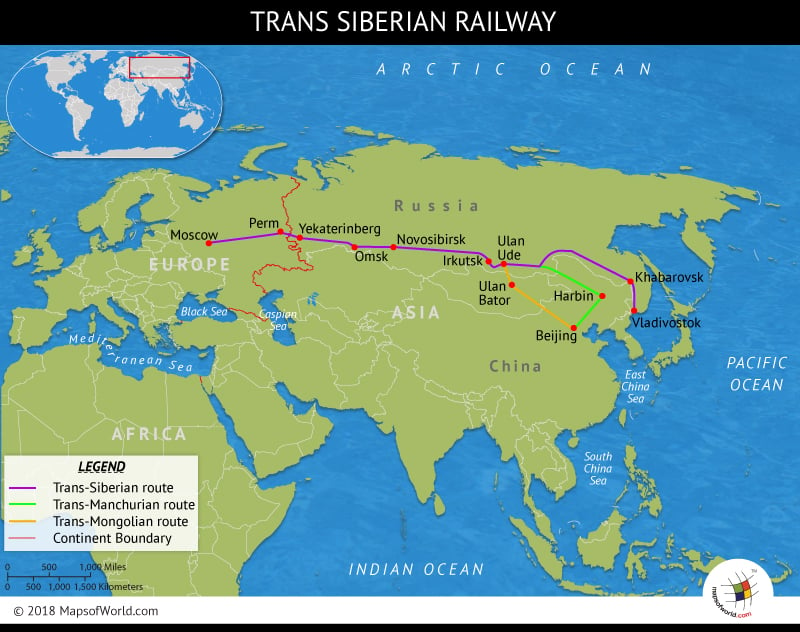What is the Trans-Siberian Railway?
The longest railway route in the world, featuring a run of 5,772 miles, the Trans-Siberian railway is a network of railways connecting Moscow to the Russian Far East. With linking branch lines into Mongolia, China and North Korea, is it one of the most spectacular achievement of a period. The Russian rail network expanded from 1,000 miles in 1860 to 45,000 miles by 1917, and is still enlarging. It is often associated with the main transcontinental Russian line, that connects various cities in the European and Asian parts of Russia. Spanning a record of eight time zones, it completes the journey in eight days, making it the third longest single and continuous service in the world.
The poor transport system in Siberia, hampered the development of the region prior to the railway. Deprived of good roads suitable for wheeled transport and dependence on water transport demanded a need for the construction of an integrated and efficient transportation system. Thus, the railway was seen as the only way to address the problem. Under the supervision of the Russian government and under the direct administration of the Tsar Alexander III, the construction of the Trans-Siberian Railway was initiated.
The inauguration of the construction of the Far East segment of the Trans-Siberian Railway, was done by the Tsarevich, in 1890. The imperial notification issued by the Russian government announced its intention to build a railway route across Siberia. In 1891, Tsar Nicholas II, inaugurated the construction of the railway in Vladivostok. The construction was patterned after the first transcontinental railroad in the U.S., with the work starting at both ends; in Vladivostok and Moscow, and building towards the center. Until the Circum-Baikal Railway was built, the line ended on either side of the Baikal lake with a four-hour ferry crossing linking the two railheads. The Amur River Line, north of the Chinese border was completed in 1916, which formed the continuous railway from Petrograd to Vladivostok. Additionally, the Chinese Eastern Railway was laid as part of the Russo-Chinese segment of the Trans-Siberian Railway, connecting Russia and China.
The strategic relevance of the railway network was seen during the war years. But the shortcomings in the railway network like delays in the supplies, men and ammunitions led to the defeat of Russia in the Russo-Japanese War. It was only after the Russian Revolution, that the Trans-Siberian Railway had fledged entirely. It served as a vital line of communication during the Siberian intervention of the Russian Civil War. During World War II, the Trans-Siberian Railway acted as a linkage between Germany and Japan. Bringing an edge to the Russian transport and travel system, the Trans-Siberian rail route was not only used to trade essential commodities but was also traversed by a large number of Jews to escape Europe.
The extension of the Trans-Siberian Railway, aided in the prosperity of the region’s agriculture. The transition from trading of grain westwards to the emerging of mills producing bread, the railway immediately filled the capacity. Large quantities of grains were exported along with civil freight and residents. It also affected the peasant migration rates, with millions of them inflowing from Western regions of Russia and Ukraine. Although, the train still lacked speed and possible weights of trains, it delivered the promise of establishing a transit route between Europe and East Asia.
The Trans-Siberian Railway, till date, remains the most important railway line of Russia. Handling 30% of Russia exports and 200,000 containers per year to Europe, the railway has ambitious plans laid ahead of it. The Russian Railways JSC, a state company, launched a program called ‘Transsib in 7 days,‘ for the accelerated delivery of containers cargo from 11 days in 2008 to 7 days in 2015. Hence, the process of laying its foundation to the efficient functioning of the railway, has resulted in a series of socio-economic developments. Siberia’s industrial revolution owes it success to the Trans-Siberian Railway.
Know more:
Related maps:



